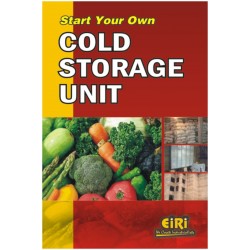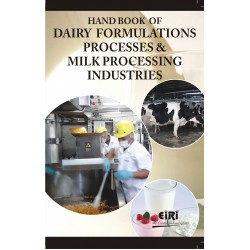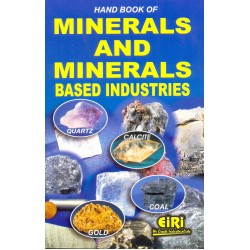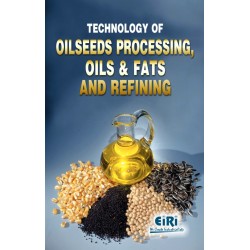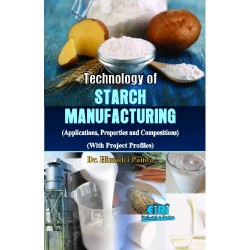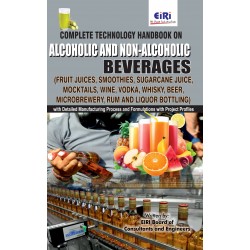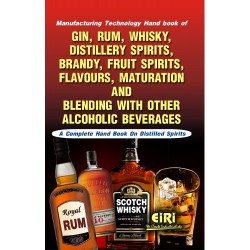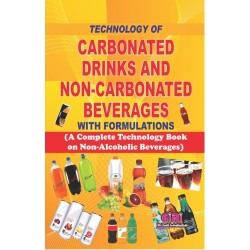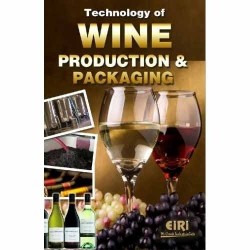Manufacturing Technology of Beer, Cereal based Beverages, Soy beverages, Fruit Wine, Vodka, Tea Beverages and other Alcoholic Beverages (A Complete Hand Book on Alcoholic Beverages)

- More than 40 years of experience
- Managed by expert industrial consultants
- ISO 9001-2015 Certified
- Registered under MSME, UAM No: DL01E0012000
- 24/5 Research Support
Get your quesries resolved from an industry expert. Ask your queries before report or book purchase. - Custom Research Service
Speak to the our consultant to design an exclusive study to serve your research needs. - Quality Assurance
All reports are prepared by highly qualified consultants & verified by a panel of experts. - Information Security
Your personal & confidential information is safe & secure.
The book Manufacturing Technology of Beer, Cereal based Beverages, Soy beverages, Fruit Wine, Vodka, Tea Beverages and other Alcoholic Beverages (A Complete Hand Book on Alcoholic Beverages) covers Fermented Beverages, Malolactic Fermentation, Production of Biogenic Amines by Malolactic Bacteria, Acetic Acid and Other Fermentations, Usages of Preservatives, Beer (Brewery Plant), Beer Treatment (Fining, Filtration and Pasteurization), Cereal based and Other fermented Drinks, Soy Juice Beverages (Drinks), Fruit Wines and Other Nongrape Wines, Aromatized Wines, Low Alcohol and Non Alcoholic Beers, Vodka Production, Tea Beverages, Aluminium Beverage can, Plant Economics ENA Plant based on Maize, Plant Economics of IMFL & Country Liquor, Plant Economics of Alcoholic Beverages and Vinegar from Coconut Water, Plant Economic of Alcoholic Drinks from Ethyl Alcohol by Mixing of Various Flavours (Flavoured Alcoholic Beverages) Plant Economics of Beer Industry and Alcoholic Beverages, Plant Economics of Blending and Bottling Plant of Country Liquor from Grain based ENA (Fully Automatic), Plant Economics of Grain Based ENA Plant (ENA Plant Based on Maize), Plant Economics of Vodka, Plant Economics of Rectified Spirit and Ethanol from Molasses.
An alcoholic beverage is a drink which contains a substantial amount of the psychoactive drug ethanol (informally called alcohol) Drinking alcohol plays an important social role in many cultures, Alcohol has potential for abuse and physical dependence.
A distilled beverage or liquor is an alcoholic beverage produced by distilling (i.e. concentrating by distillation) ethanol produced by means of fermenting grain, fruit, or vegetables. Unsweetened, distilled, alcohlloic beverages that have an alcohol content of at least 20% ABV are called spirits. For the most common distilled beverages. such as whiskey and vodka, the alcohol content is around 40%. The term hard liquor is lused in North America to distinguish distilled beverages from undistilled ones (implicity weaker). Vodka, gin, baijiu, tequila, whiskey, brandy, and soju are examples of distilled beverages. Distilling concentrates the alcohol and eliminates some of the congeners. Freeze distillation concentrates ethanol along with methanol and fusel alcohols (fermentation by-products partially removed by distillation) in applejack. Paracelsus gave alcohol its modern name, which is derived from an Arabic word that means finely divided.
The book contains the following 24 chapters on fermented beverages, Malolactic Fermentation with process and Microbial Stability, Production of Biogenic Amines by Malolactic Bacteria, Acetic Acid and Other Fermentations, Usages of Preservatives, beer (Brewery Plant), beer Treatment (Fining, Filtration and Pasteurization), Cereal based and other fermented Drinks, Soy Juice Beverages (Drinks), Fruit Wines and other Nongrape Wines, Aromatized Wines, Low Alcohol and Non- Alcoholic Beers, Vodka Production, Tea Beverages, Aluminium Beverage Can, Plant Economics ENA Plant Based on Maize, Plant Economics of I M F L & Country Liquor, Plant Economics of Alcoholic beverages and Vinegar from Coconut Water, Plant Economics of Alcoholic Drinks from Ethyl Alcohol by Mixing of Various Flavours (Flavoured Alcoholic Beverages), Plant Economics of Beer Industry and Alcoholic Beverages, Plant Economics of Blending and Bottling Plant of Country Liquor from grain based ENA (Fully Automatic), Plant Economics of Grain based ENA Plant (ENA Plant Based on Maize). Plant Economics of Vodka, Plant Economics of Rectified Spirit and Ethanol from Molasses.
FERMENTED BEVERAGES
- Alcoholic Fermentation
- Physiology and Morphology of Yeast
- Nutritional Requirements of yeast
- The Killer Factor
- Fermentation Vessels
- The Growth of a Yeast Population
- An Overview of Alcoholic Fermentation
- Flocculation
- Aroma Compounds and Fermentation
- Some odorous byproducts of fermentation
MALOLACTIC FERMENTATION
- Malolactic Bacteria: Morphology and Physiologyl
- Identification of Malolactic Bacteria
- Factors Affecting the Growth of Malolactic Bacteria
- pH
- Sulfur Dioxide
- Contact with yeast Lees
- Temperature
- Alcohol Concentration
- Sorbic acid
- Spontaneous Malolactic Fermentation
- Inoculation with MLB Starter Culture
- The Malolactic Fermentation Process
- Production of Diacetyl
- Microbial Stability
PRODUCTION OF bIOGENIC AMINES BY MALOLACTIC BACTERIA
- Malolactic Fermentation and Aroma
- Diacetyl
- Hydrolysis of Grape Aroma Compounds
- Production of Volatile Phenols
ACETIC ACID AND OTHER FERMENTATIONS
- Acetic Acid Bacteria
- Characteristics of acetic acid bacteria and Gluconobacter oxydans
- Lactic Acid Bacteria
- The Activities of Yeasts other than Saccharomyces
- Film Forming Yeasts
- Molds
- Prevention of Spoilage
USAGES OF PRESERVATIVES
- Sulfur Dioxide (SO2)
- Various forms of free sulfur dioxide in solution
- Binding of SO2 species by carbonyl compounds
- The Roles of SO2
- Possible ways in which sulfites may inhibit growth of microorganisms
- Profile of the most common yeasts found in grape juice fermentations
- Sorbic Acid
- Formation of malodorous products from sorbic acid
- DMDC (Velcorin)
- Ascorbic Acid (Vitamin C)
- Pimaricin (Natamycin)
BEER (BREWERY PLANT)
- The basic brewing processes (optional items are given in square brackets)
- Malting and Mashing
- Schematic cross section through a barley grain
- Barley germination
- Glucose based carbohydrates in barley and malt
- Grubbing the malt on kilchoman distillery malting floor
- Grain washing drum
- Conical steep
- ECO steep
- Germbox horizontal germination plant
- Traditional and modern maltings equipemnt
- Summary of the Maillard reaction
- Some characteristics of common barley malts
- Boiling the Wort
- Grist hopper and
- Grist mill at Holden's
- Closed kettles with stacks
- Hop back at Hardy's and Hanson's brewery
- Detail of the gas heating
- Electric heating
- Enclosed kettle with stack at Hardy's and Hanson's brewery
- Plate heat exchanger
- Some prefermentation brewery equipment
- Salt hydrolysis, effect of Ca on mash acidity and methods for reducing liquor or mash pH
- Some bittering and aroma constituents of hops
- Isomerization of humulone during boiling of hopped wort
- Fermentation
- Top Fermentation
- Yorkshire square at hardy's and Hansons Brewery
- Enclosed fermentation vessel at Jennings Brewery
- Union casks at Firestone Walker Brewery
- Rousing fermenting wort in a vessel
- Medium yeast propagation vessel at Belhaven Brewery. Smaller and larger vessels form the complete system
- Rousing fermenting wheat beer wort
- Some fermentation vessels and systems
- Bottom fermention
BEER TREATMENT (FINING, FILTRATION AND PASTEURIZATION)
- Beer styles
- Abbey Beers
- Altbier
- Barley Wine
- Bitter
- Altbier
- Bock, Doppelbock and Related Styles
- Brown Ale
- Cream Ale
- Flavored Beers
- Honey Beers
- Lambic Beer
- Malzbier
- Marzenbier
- Mild
- Munchner
- Old Ale, Strong Ale and Stock Ale
- Pale Ale
- Pilsener
- Porter
- Rauchbier
- Red Beer
- Roggenbier
- Sahti and Koduolu
- Saison
- Scotch Ales
- Sourish Shchi
- Steam Beer
- Steinbier
- Wheat Beer
CEREAL BASED AND OTHER FERMENTED DRINKS
- The Rice wines of Asia
- Cloudy Rice Wines
- Refined Rice Wines
- The Traditional Korean Rice Wine Production process
- Preparation of Nuruk
- Simplified scheme for the production of traditional Korean rice wine
- Preparation of nuruk
- Brewing process
- Filtration
- Use of a traditional rice wine strainer to make chungju
- Traditional Rice Wine in Japan
- Traditional Chinese Rice Wine
- Types of Japanese rice wine
- Traditional Rice wine of Vietnam
- Nature of the Rice Wine Starter
- Flavored Korean Rice Wines
- Native Fermented Drinks of Africa and South America
- Scheme illustrating the production of tchapalo and similar drinks
- African brews
- Scheme showing traditional production of pulque
SOY JUICE BEVERAGES (DRINKS)
- Tasking Soy Protein Beyond Milk
- Space increase
- Different methods
- Emulsifying and stabilising
- Albimin
- water soluble
- Total Protein
- Glycine max
- Globulins
- Brine soluble
- 11S Glycinin
- 7S conglycinin
- 7S conglycinin enzymes
- 2 S BBL conglycinin
- 15S Glycinin polymer
- Soy protein isolate that are usually recommended for
- Beverage application
- Stabilising droplets
- Acidified drinks
- Typical nutrient analysis
- Nutritional information
- Bioactive soy drinks
- Logical platform
- Market positioning of soy juice beverages
- Fruit flavoured
- soy beverages
- Spin offs
- Satiety worker
- Formulation
- Solubility index
- Insoluble source
- Nitrogen
- Solubility
- Index%
- Processing suggestions for shelf -S table soy milk
- Base soy milk formula suggestion
- Typical neutral pH soy beverage formula
- Nutraceutical soy juice beverage formula
FRUIT WINES AND OTHER NONGRAPE WINES
- Comparison of fruit for Winemaking
- Sugar and acid content of crushed fruit used to make fruit wines
- Some characteristic phenolic substances of fruits used to make fruit wine
- Total phenolic content and anthocyanin content of some fruits commonly used to make fruit wines
- Making fruit wines
- Characteristic aroma compounds of some fruits
- Summary of processes used to make fruit wines and country wines
- Infusion techniques for making fruit wines
- Some anthocyanin derived pigments in soft fruit
- Thermal degradation of anthocyanins from elderberry and strawberry
- Country Wine Styles
AROMATIZED WINES
- Vermouth
- Two methods for the manufacture of vermouth
- Short list of herbs used to make Vermouth and their typical aroma compounds and bitter agents
- Some flavour compounds in vermouth
- Other Aromatized Wines
- Lignans, pentacyclic triterpenoids and phenolic compounds from botanicals used in the manufacture of vermouth
LOW ALCOHOL AND NON ALCOHOLIC BEER
- Production of Low Alcohol Beverages by Limited or Checked Alcohol Methods
- Spent grain (high gravity mash) method
- Low alcohol beers from checked or limited fermentation methods
- Dealcoholization Methods
- Summary of methods for the dealcoholization of beer
- Perspective section and horizontal half section through part of a spinning cone column device
VODKA PRODUCTION
- Distillation
- Plain vodka
- Flavored and colored vodka
- Distilling Femented fruit, Grains or Alcoholic Infusions
- Natural Distilled Fruit Vodka or Liqueur
- Commercial producers solve the problem by adding officialy approved food colorings
- Distilling Infusions
- Making Vodkas by Mixing Method
- Natural fruit vodka
- Making natural fruit Vodka
- Sweet Vodkas
- Use of Extracts and Essential Oils
- General guidelines
TEA BEVERAGES
- Chemical formula
- Schematic chart of a working procedure of Test-2
- Graph showing the results of the determination by high performance liquid chromatography (HPLC)
- Graph showing the results of the determination by HPLC of strictinin contents and ellagic acid
- Graph as determined in Test 11 that the occurrence or non occurrence of the secondayr sediment is piotted on the coordinate the abscissa axis
- Graph as determined in Test 11 that the occurrence
- Graph as determined in Test 12 that the occurrence or non occurrence of the secondary sediment is plotted on the coordinate the abscissa axis
- Graph as determined in Test 12 that the occurrence or non occurrence of the secondary sediment is plotted on the coorrdinate the abscissa axis
- Description
- Dertermination of Strictinin Content
- Test-1 (Sediment forming test
- Test 2 (Analysis Test on Sediment Components)
- Test-3 (Characteristic Property of Strictinin in Beverage Process)
- Test 4 (Heat Decomposition Test of Strictin)
- Test 5 (Comparison Test of pH at the Extraction)
- Test 6 (Comparison of the Extracted Amount of strictinin in the Acidic Extraction)
- Test-7 (Comparison of Extraction Time)
- Test 8 (Ellagic Acid Adding Test)
- Test 9 (Analysis of Components involved in the Sediment Formation in the HP 20 Unadsorbed Fraction)
- Test 10 (Model Test Using Amino Acids and Proteins)
- Test 11 (Correlation Between Strictinin Concentration in Tea and Sediment)
- Test 12 (Correlation Between Strictinin Concentration in Tea and Sediment)
ALUMINIUM BEVERAGE CAN
- Steps in Can Manufacture
- Drawing and ironing
PLANT ECONOMICS OF ENA PLANT BASED ON MAIZE
- Plant & Machinery
- Fixed Capital
- Raw Materials
- Total Working Capital/Month
- Total Capital Investment
- Turn Over/Annum
PLANT ECONOMICS OF IMFL & COUNTRY LIQUOR
- Plant & Machinery
- Fixed Capital
- Raw Materials
- Total Working Capital/Month
- Total Capital Investment
- Turn Over/Annum
PLANT ECONOMICS OF ALCOHOLIC BEVERAGES AND VINEGAR FROM COCONUT WATER
- Plant & Machinery
- Fixed Capital
- Raw Materials
- Total Working Capital/Month
- Total Capital Investment
- Turn Over/Annum
PLANT ECONOMICS OF ALCOHOLIC DRINKS FROM ETHYL ALCOHOL BY MIXING OF VARIOUS FLAVOURS (FLAVOURED ALCOHOLIC BEVERAGES)
- Plant & Machinery
- Fixed Capital
- Raw Materials
- Total Working Capital/Month
- Total Capital Investment
- Turn Over/Annum
PLANT ECONOMICS OF BEER INDUSTRY AND ALCOHOLIC BEVERAGES
- Plant & Machinery
- Fixed Capital
- Raw Materials
- Total Working Capital/Month
- Total Capital Investment
- Turn Over/Annum
PLANT ECONOMICS OF BLENDING AND BOTTLING PLANT OF COUNTRY LIQUOR FROM GRAIN BASED ENA (FULLY AUTOMATIC)
- Plant & Machinery
- Fixed Capital
- Raw Materials
- Total Working Capital/Month
- Total Capital Investment
- Turn Over/Annum
PLANT ECONOMICS OF GRAIN BASED ENA PLANT (ENA PLANT BASED ON MAIZE)
- Plant & Machinery
- Fixed Capital
- Raw Materials
- Total Working Capital/Month
- Total Capital Investment
- Turn Over/Annum
PLANT ECONOMICS OF VODKA
- Plant & Machinery
- Fixed Capital
- Raw Materials
- Total Working Capital/Month
- Total Capital Investment
- Turn Over/Annum
PLANT ECONOMICS OF RECTIFIED SPIRIT AND ETHANOL FROM MOLASSES
- Plant & Machinery
- Fixed Capital
- Raw Materials
- Total Working Capital/Month
- Total Capital Investment
- Turn Over/Annum
How to Make Project Report?
Detailed Project Report (DPR) includes Present Market Position and Expected Future Demand, Technology, Manufacturing Process, Investment Opportunity, Plant Economics and Project Financials. comprehensive analysis from industry covering detailed reporting and evaluates the position of the industry by providing insights to the SWOT analysis of the industry.
Each report include Plant Capacity, requirement of Land & Building, Plant & Machinery, Flow Sheet Diagram, Raw Materials detail with suppliers list, Total Capital Investment along with detailed calculation on Rate of Return, Break-Even Analysis and Profitability Analysis. The report also provides a birds eye view of the global industry with details on projected market size and then progresses to evaluate the industry in detail.
We can prepare detailed project report on any industry as per your requirement.
We can also modify the project capacity and project cost as per your requirement. If you are planning to start a business, contact us today.
Detailed Project Report (DPR) gives you access to decisive data such as:
- Market growth drivers
- Factors limiting market growth
- Current market trends
- Market structure
- Key highlights
Overview of key market forces propelling and restraining market growth:
- Up-to-date analyses of market trends and technological improvements
- Pin-point analyses of market competition dynamics to offer you a competitive edge major competitors
- An array of graphics, BEP analysis of major industry segments
- Detailed analyses of industry trends
- A well-defined technological growth with an impact-analysis
- A clear understanding of the competitive landscape and key product segments
Need Customized Project Report?
- Ask for FREE project related details with our consultant/industry expert.
- Share your specific research requirements for customized project report.
- Request for due diligence and consumer centric studies.
- Still haven't found what you're looking for? Speak to our Custom Research Team
About Engineers India Research Institute:
Our Approach
- Our research reports comprehensively cover Indian markets (can be modified as per your country), present investigation, standpoint and gauge for a time of five years*.
- The market conjectures are produced on the premise of optional research and are cross-accepted through associations with the business players
- We use dependable wellsprings of data and databases. What's more, data from such sources is handled by us and incorporated into the report
Why buy EIRI reports?
- Our project reports include detailed analysis that help to get industry Present Market Position and Expected Future Demand.
- Offer real analysis driving variables for the business and most recent business sector patterns in the business
- This report comprehends the present status of the business by clarifying a complete SWOT examination and investigation of the interest supply circumstance
- Report gives investigation and top to bottom money related correlation of real players/competitors
- The report gives gauges of key parameters which foresees the business execution






















